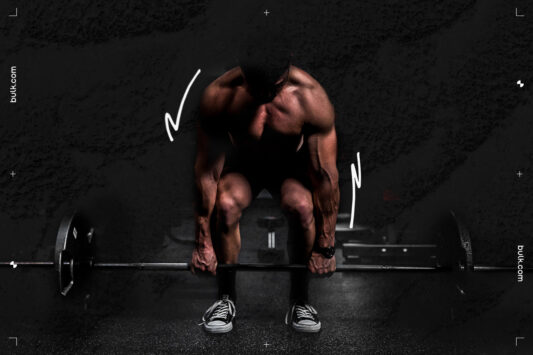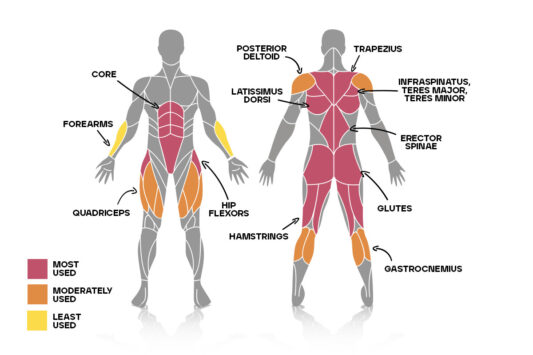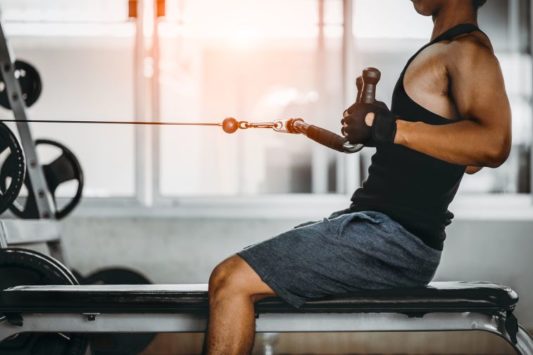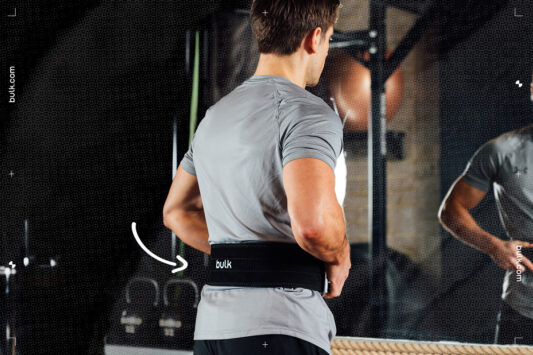Pull day is a crucial component of any well-rounded fitness regimen as it targets the complex musculature of the upper and lower back, as well as the biceps and forearms. Here we look at everything you need to know about pull day, exploring the principles behind building a strong and functional back.
Whether you’re a novice or an advanced lifter, we provide evidence-based information on the most effective exercises, pull workouts, and training routines. Our goal is to help you optimise your workouts and achieve a strong, healthy and functional posterior chain.
What is pull day?
Pull day is a gym session that involves pulling exercises such as deadlifts, curls, pull-ups and rows. These movements build your back and upper body muscles, including your lats, traps, rhomboids, erector spinae and biceps. It is typically part of a push-pull-legs (PPL) training split.
By adding pulling exercises to your routine, you can build a muscular upper body and improve your posture by strengthening the muscles that support your spine.
What are the best pull day exercises?
1. Deadlifts
Deadlifts work the erector spinae muscles of the lower back, as well as the glutes, quadriceps and hamstrings. Additionally, they engage the lats, traps, and rear deltoids as stabiliser muscles.
The king of compound movements, deadlifts are fundamental to most resistance training programmes. Whether you’re training for strength or building muscle mass, deadlifts have a place in every single muscle training programme.
To perform the deadlift, stand with feet shoulder-width apart, bend your knees, hinge at the hips, grasp the bar with both hands, and lift it by driving heels into the ground until you are fully standing upright. For much greater detail on how to perform this movement, see our blog on how to increase your deadlift.
2. Pull-ups
Pull-ups mainly target the latissimus dorsi muscle of the back, as well as the biceps and forearms as secondary movers.
Hang from a bar with an overhand grip, pull yourself up by bending your elbows and pulling your chin over the bar, then lower yourself back down. If you struggle with these at body weight (and they are tough), don’t be afraid to do these exercises. Like with all back exercises, you’ll get better results with proper form.
3. Lat Pulldowns
Lat pulldowns focus on the latissimus dorsi muscles, rhomboids, and middle and lower trapezius. They also create moderate stimulation for the biceps.
Sit at a pulldown machine, grasp the bar with an overhand grip wider than shoulder-width apart, pull the bar down to your chest by squeezing your shoulder blades together, and then release back up.
So many people do this movement wrong. To avoid this, the key is to make sure you retract your scapula. Your back should not be dead straight while doing these movements. As you contract, lean back a little and allow for full contraction of the lats.
4. Barbell Bent-over Rows
To perform barbell rows, stand with feet shoulder-width apart, bend your knees slightly, grasp the barbell with an overhand grip, lift it off the ground, pull it up to your chest by squeezing your shoulder blades together, then release back down.
Barbell rows work the latissimus dorsi, rhomboids, middle and lower trapezius, erector spinae and rear deltoids.
5. Dumbbell Rows
Place one knee and hand on a bench, holding a dumbbell with your other hand, pull the dumbbell up towards your ribcage by squeezing your shoulder blades together, then release back down. You can do this unilaterally(single-arm), or bilaterally (both arms).
Dumbbell rows engage the latissmus dorsi, rhomboids, middle and lower trapezius and rear deltoids.
6. Seated cable rows
Sit on the cable row machine. Change the pin to alter resistance. Place your fee in position, grab hold of the grip and pull. Ensure you retract your shoulders and squeeze at the top of the movement. Ease the cable back slowly and repeat.
Seated cable rows work the same muscles as dumbbell rows. However, the movement is tackled from a different angle and uses the cable as resistance rather than a dumbbell.
6. Dumbbell Pullovers
Lie on a bench with a dumbbell on the floor, underneath your head. Grasp the dumbbell with both hands. With your arms slightly bent, move the dumbbell over your head in an arc motion until it reaches your thighs. Slowly return to the starting position.
Cable pullovers primarily target the latissimus dorsi muscles, as well as the pecs, triceps, and serratus anterior muscles.
7. Dumbbell Shrugs
Pick up two heavy dumbbells, then step back into space. Shrug your shoulders upwards, holding and squeezing your traps at the top of my movement.
Dumbbell shrugs mainly work the trapezius muscles, particularly the upper portion, along with the levator scapulae muscles.
8. Face Pulls
Attach a rope to a cable machine, hold the rope with both hands, pull the rope towards your face while squeezing your shoulder blades together, then release back to starting position. The eccentric contraction here is as important as the concentric, so take your time with it. Slow and controlled.
Face pulls target the posterior deltoids (back of the shoulder), as well as the trapezius and rhomboid muscles.
Another great movements for the posterior deltoids are Rear Delt Flyes. This helps create that rounded looked on your shoulders.
9. Bicep Curls
Hold a dumbbell with an underhand grip, curl the dumbbell towards your shoulder while keeping your elbows stable, then slowly release back down. You can also do this with a barbell or EZ bar.
There are other variations, such as Hammer Curls, which are performed with a neutral grip (your hand pointing up as if you’re holding a hammer). For more information on the best variations, see our article on how to get bigger biceps.
Bicep curls primarily work the biceps brachii muscles, along with the brachialis and brachioradialis muscles. Additionally, they engage the forearm flexors as secondary movers.
Pull day workout routine examples
Here are some examples of pull workouts for you to try.
Pull day one
Deadlift 5×5
Lat Pulldown (wide-grip) 3×5-8
Seated Cable Row 3×10-12
Bent-Over Dumbbell Row 3×6-8
Dumbbell Rear-Delt Fly 3×12-15
Dumbbell Bicep Curl 3×8-10
Pull day two
Pull-up 8×4
Bent-Over Barbell Row 3×10-12
Cable Row 3x 5-8
Dumbbell Pull-Over 3×10-12
EZ Bar Bicep Curl 3×6-10
Dumbbell Hammer Curl 3×6-10
Another pull day
Deadlifts, Pull-ups or Bent-over row
Lat Pulldown (narrow, neutral grip) 3×8-10
Seated Horizontal Row 3×8-10
Vertical Cable Pullovers (EZ Bar, Supinated Grip) 3×10-12
Face pulls 3×10
(Super Set) Standing Barbell Biceps Curl 3×10 + Cable (Rope) Biceps Hammer Curl 3xAMRAP
How to structure your own pull day workout
In pull workouts, it’s important to always get at least one or two compound movements in. These include exercises like deadlifts, pull-ups and bent-over rows. Most people like to perform these as the first movement when they’re most fresh.
If you complete two pull days a week, it’s a good idea to switch the priorities of your exercises. For example, let’s say you begin with vertical movements for one, followed by the exercises which target more of the thickness (horizontal). You’ll want to switch the order of those exercises around to ensure your volume is as equal as possible.
Compound movements
Compound movements are exercises that use multiple muscle groups at the same time. The deadlift is a great example for pull day, as it stimulates the entire posterior chain. This makes it an essential movement for building a bigger back.
Isolation movements
Isolation movements target one muscle group intensely while being light on the others. A good example of this is the bicep curl. The only muscles worked are the biceps brachii.

What’s the best pull day warm-up?
A good warm-up can help increase blood flow, flexibility, and mobility, which can reduce the risk of injury and improve your overall performance. The best way to warm up for pull day is to perform a series of dynamic stretching exercises that focus on the muscles you will be using during your workout.
Some examples of warm-up exercises for pull day include arm circles, shoulder dislocations, thoracic rotations, and bodyweight rows. Retained bands are also great, if you have one, to add some light resistance.
Additionally, you can perform some light repetitions of movements at hand. This is especially important for big compound lifts like deadlifts or bent-over rows.
What’s the best pull day training split to use?
Three-day split
A three-day split would consist of a PPL (push, pull and legs). This allows you to hit every major muscle group in three training days, including one pull day.
Some people complete this split twice per week, resulting in six days in the gym. In this case, it’s important to mix the exercises on your pull days up.
Five-day split
Alternatively, you can opt for the five-day split which would consist of a pull day, push day, leg day, then an upper day (chest and shoulders) and lower day (legs and pull).
As well as vertical and horizontal pulling motions, it’s important to remember that the shoulders and traps are activated using upright rowing movements and lateral movements as well.
Tips for a successful pull day workout
Start with the compound movement
Begin the session with heavy compound movements, such as deadlifts or bent-over rows. This is because you are most fresh, and allows you to perform these more demanding movements to the best of your ability. It also acts as a good warm-up to your other movements, as many of them will have already had some stimulation.
Use proper technique and form
Like any exercise, technique and proper form are essential to getting good results. For big compound movements, the technique is essential to avoid injury. For isolation, it’s important to get the most muscle stimulation. Take things slowly. Take your time. Squeeze on contraction.
Track your workouts
Another important aspect of muscle building in general. Tracking your workouts allows you to ensure you are getting good progressive overload. By adding resistance every couple of weeks, you are ensuring the muscle is constantly being worked to a level that will see it grow. So keep track of your workouts, either through notes or a sheet or a programme.
Use equipment
For the heavier lifts, such as big deadlifts, make sure to use the correct equipment. This includes a weightlifting belt and lifting straps.
Frequently Asked Questions
How is pull day different from push day?
Pull day uses pulling movements that work the posterior (back) chain, such as deadlifts and rows. Push day, however, uses pressing movements that work the anterior (front) chain, such as bench presses, shoulder presses and push-ups.
Can you do pull and legs on the same day?
Yes, it’s pretty common to do these on the same day. Some movements, like the deadlift and bent-over rows, already have some level of leg involvement (particularly deadlifts), so it makes sense to continue that. Many people pair deadlifts with Romanian deadlifts, or squats, for example.
Can you do push and pull on the same day?
Of course. It’s common to mix and match movements in a full-body programme. Some people find better results by spreading out the volume between exercises each day. Rather than hammering one muscle group multiple times a week, spreading the load out has some benefits. It needs to be considered, however, as it’s easy to have unequal volume if workouts are not tracked properly.
Is back and biceps a pull day?
Back and biceps is essentially another way to describe a pull day, since the movements in a pull day tend to work the back and bicep muscle groups. These movements include deadlifts, lat pulldowns, rows and bicep curls.
What does push, pull and legs (PPL) mean?
In order to hit every muscle group twice per week, a popular method of combining muscle groups is to split up lower body movements, pushing movements and pulling movements.
For each of these groups, the best way to maintain a variety of movements is to create two different sets of exercises for the same muscle group.
Why is it important to train back?
One of the most important features when it comes to creating a well-rounded, proportionally sound physique is the back. Your back is also important when it comes to performing big compound movements like the barbell back squat and the deadlift.
By having a strong back, you’re more able to activate your lats throughout the pulling motion of the deadlift in order to keep your back straight and reduce the risk of injury. As well as this, having a stronger back also helps push movements such as bench press. It provides a base for your anterior muscle to work from.
Related articles: Back exercises and pull day
Eager to learn more? We believe that every person, with support, has the right to transform their lives through fitness. That’s why we’ve put together hundreds of articles with expert advice, all to help you on your fitness journey. Check out our relevant articles below:
Benefits of rack pulls
How to build calf muscles
What does a weightlifting belt do?
Teres major exercises
Push shoulder exercises
Fitness training methods
Romanian deadlift vs deadlift
Dumbbell shoulder workout














